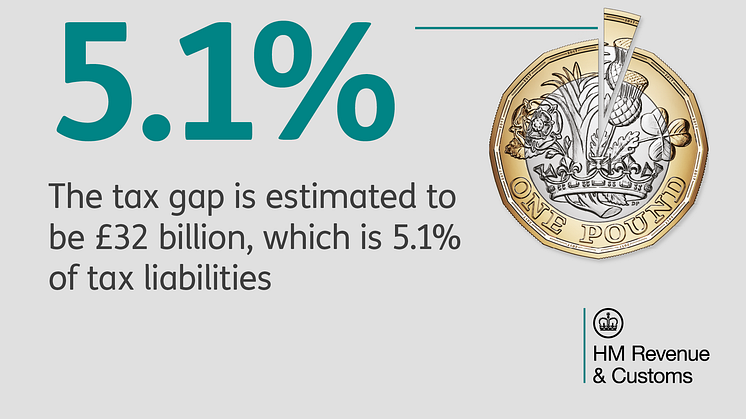
Press release -
Tax gap remains steady at 5.1%
Statistics published today (23 June) by HM Revenue and Customs (HMRC) reveal the estimated tax gap for the 2020 to 2021 tax year is 5.1% – the second lowest recorded percentage – and is unchanged from the previous year.
The annual Measuring Tax Gaps publication estimates the difference between the total amount of tax expected to be paid and the total amount of tax actually paid during the financial year. The majority of taxpayers pay the tax that is owed.
In monetary terms, the tax gap for the 2020 to 2021 tax year is £32 billion. At 5.1%, there has been no change in the percentage tax gap compared to the previous year, although the monetary value has fallen by £2 billion from £34 billion in the 2019 to 2020 tax year.
The total tax due to be paid fell from £672 billion in 2019 to 2020 to £635 billion in 2020 to 2021 due to the economic impact of COVID-19.
Jonathan Athow, HMRC’s Director General for Customer Strategy and Tax Design, said:
“The vast majority of taxpayers and businesses paid the correct amount of tax owed. We want to help everyone to get their tax right as the revenue we raise helps fund our vital public services.”
The estimate for the 2020 to 2021 tax gap is the best assessment based on the evidence available at this time. There is some uncertainty for the tax gap estimates for the first year of the pandemic and estimates could be subject to revisions in future years.
HMRC has published tax gap estimates since the 2005 to 2006 tax year. There has been a long-term reduction in the overall tax gap from 7.5% in 2005 to 2006, to 5.1% in the 2020 to 2021 tax year. The reduction is a result of the government’s action to help taxpayers get their tax right first time, whilst bearing down on the small minority who are deliberately non-compliant.
Further findings for the 2020 to 2021 tax gap publication show:
- the tax gap for Income Tax, National Insurance contributions and Capital Gains Tax is 3.5% (£12.7 billion), representing 39.5% of the total tax gap by type of tax
- the VAT gap shows a strong downward trend falling from 14.1% in 2005 to 2006 to 7.0% in 2020 to 2021
- the Corporation Tax gap reduced from 11.5% in 2005 to 2006, to 9.2% in 2020 to 2021, reaching a low of 6.5% in 2011 to 2012, remaining broadly stable since 2014 to 2015
- at 48% (£15.6 billion), small businesses represent the largest proportion of the tax gap by customer group, followed by criminals at 16% (£5.2 billion)
- individuals account for 8% (£2.5 billion) of the overall tax gap and, at 5% (£1.5 billion), wealthy individuals have the smallest tax gap by customer group
- failure to take reasonable care (19%), criminal attacks (16%), non-payment (15%) and evasion (15%) are the main reasons for the tax gap by behaviour.
HMRC publishes the tax gap because it believes it is important to be transparent in its work. The data helps build trust in HMRC’s ability to support taxpayers in meeting their obligations and pay the tax they owe. It also helps inform the future work and priorities for HMRC, and where it can make the greater difference for taxpayers.
HMRC is the only tax authority in the world that measures and publishes an annual tax gap in such a comprehensive way – covering a single tax year for all the taxes, levies and duties it administers.
Each year, HMRC estimates the tax gap for direct and indirect taxes based on the latest available information. HMRC may revise previous years’ tax gaps as more data becomes available in order to show the long-term trend.
Notes to Editors
- The Measuring Tax Gaps 2022 publication was published on 23 June 2022.
- HMRC’s tax gap estimates are official statistics produced in accordance with the Code of Practice for Statistics, which assures objectivity and integrity. Tax gap estimates are reviewed each year to reflect updated data and methodologies.
- Follow HMRC’s Press Office on Twitter @HMRCpressoffice
Topics
Categories
Issued by HM Revenue & Customs Press Office
HM Revenue & Customs (HMRC) is the UK’s tax authority.
HMRC is responsible for making sure that the money is available to fund the UK’s public services and for helping families and individuals with targeted financial support.



